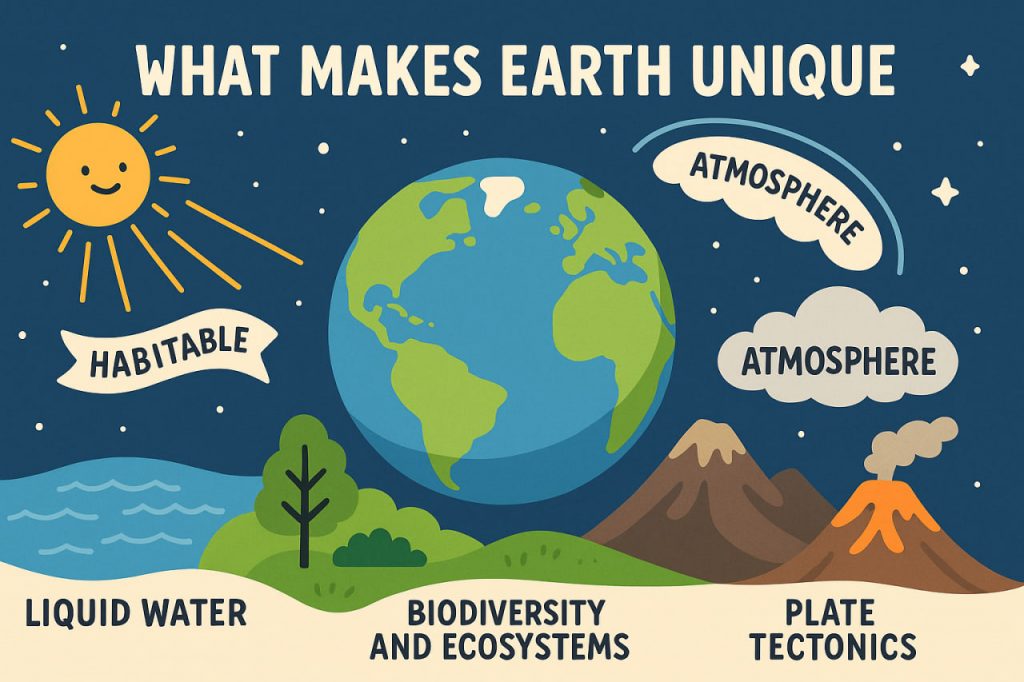Among all the planets in our Solar System—and the billions more beyond—Earth is the only one we know that supports life. Its perfect balance of conditions has allowed oceans, forests, mountains, animals, and humans to exist and thrive. But what exactly makes Earth so unique?
The Right Distance from the Sun
Earth orbits in the habitable zone, sometimes called the “Goldilocks zone”—not too hot, not too cold. This location allows water to exist in liquid form on the surface. Planets that are too close to the Sun, like Venus, are scorching hot; those too far, like Mars, are too cold for stable surface water. Earth’s position gives it just the right conditions for life to evolve and survive.
Liquid Water: The Essential Ingredient
Water is critical for all known life. Earth has vast oceans, rivers, lakes, and even underground water reserves. No other planet has been confirmed to hold as much liquid water on its surface. Water helps regulate the climate, shapes the landscape, and supports millions of species—from bacteria to whales.
The presence of water in all three states—solid (ice), liquid, and gas (vapor)—is also key to Earth’s climate stability.
A Life-Supporting Atmosphere
Earth’s atmosphere is a perfect blend: about 78% nitrogen, 21% oxygen, and trace amounts of carbon dioxide, argon, and water vapor. This mixture protects us from harmful solar radiation, provides oxygen for breathing, and traps enough heat to keep the planet warm through the greenhouse effect—without overheating.
The ozone layer, part of the atmosphere, shields Earth from dangerous ultraviolet rays from the Sun.
A Magnetic Shield
Earth has a magnetic field generated by its liquid iron core. This invisible field surrounds the planet and protects it from solar wind—streams of charged particles from the Sun. Without this shield, radiation would strip away the atmosphere and damage life on the surface.
Mars, for example, lost much of its atmosphere partly because it lacks a strong magnetic field.
Plate Tectonics and Recycling Earth’s Crust
Earth is the only known planet with plate tectonics—the slow movement of massive plates in the outer layer of the planet. These movements recycle nutrients, create mountains, regulate carbon levels, and drive natural cycles that keep the environment dynamic and stable over time.
Volcanic activity, earthquakes, and the shifting of continents all play roles in shaping ecosystems.
Biodiversity and Ecosystems
Earth supports an incredible variety of life—estimated at over 8 million species. From tropical rainforests to polar ice caps, life has adapted to nearly every environment. The biosphere—Earth’s network of life—works in harmony with the atmosphere, hydrosphere (water), and geosphere (land), forming a complex, interconnected system.
No other planet has shown evidence of such complexity.
Glossary
- Habitable zone – The region around a star where conditions allow liquid water.
- Atmosphere – The layer of gases surrounding Earth.
- Greenhouse effect – The trapping of heat by gases in the atmosphere to warm the planet.
- Magnetic field – A protective shield generated by Earth’s core.
- Plate tectonics – Movement of Earth’s outer plates that shapes the surface and recycles minerals.
- Biosphere – The global system of all living organisms and their environments.


